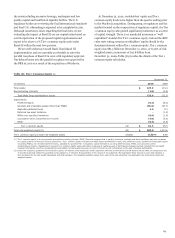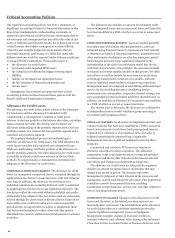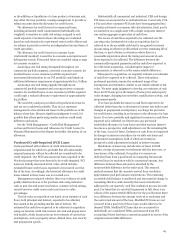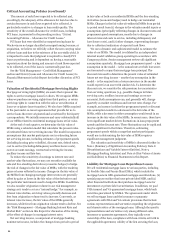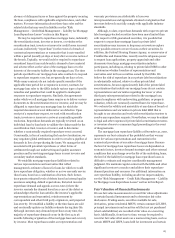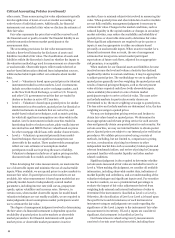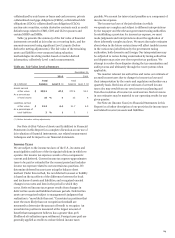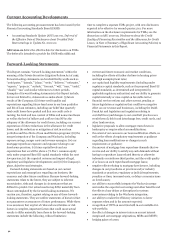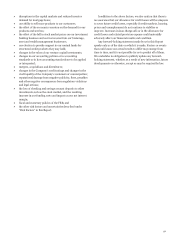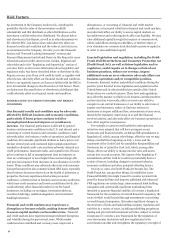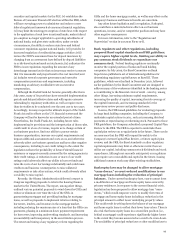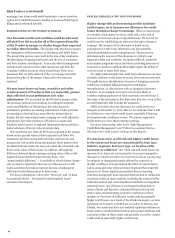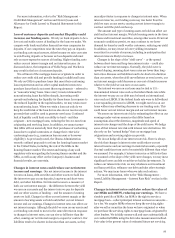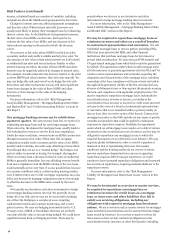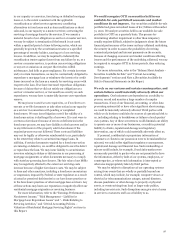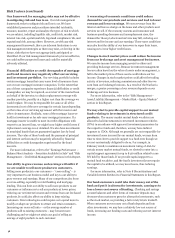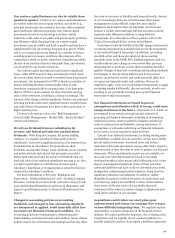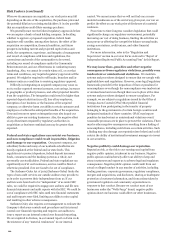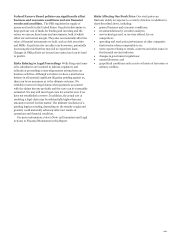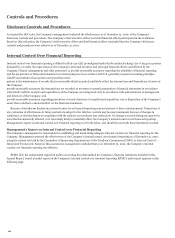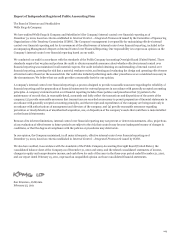Wells Fargo 2010 Annual Report Download - page 95
Download and view the complete annual report
Please find page 95 of the 2010 Wells Fargo annual report below. You can navigate through the pages in the report by either clicking on the pages listed below, or by using the keyword search tool below to find specific information within the annual report.securities and capital markets by the SEC; (v) establishes the
Bureau of Consumer Financial Protection within the FRB, which
will have sweeping powers to administer and enforce a new
federal regulatory framework of consumer financial regulation;
(vi) may limit the existing pre-emption of state laws with respect
to the application of such laws to national banks, makes federal
pre-emption no longer applicable to operating subsidiaries of
national banks, and gives state authorities, under certain
circumstances, the ability to enforce state laws and federal
consumer regulations against national banks; (vii) provides for
increased regulation of residential mortgage activities; (viii)
revises the FDIC's assessment base for deposit insurance by
changing from an assessment base defined by deposit liabilities
to a risk-based system based on total assets; (ix) authorizes the
FRB to issue regulations regarding the amount of any
interchange transaction fee that an issuer may receive to ensure
that it is reasonable and proportional to the cost incurred; and
(x) includes several corporate governance and executive
compensation provisions and requirements, including
mandating an advisory stockholder vote on executive
compensation.
Although the Dodd-Frank Act became generally effective in
July 2010, many of its provisions have extended implementation
periods and delayed effective dates and will require extensive
rulemaking by regulatory authorities as well as require more
than 60 studies to be conducted over the next one to two years.
Accordingly, in many respects the ultimate impact of the Dodd-
Frank Act and its effects on the U.S. financial system and the
Company will not be known for an extended period of time.
Nevertheless, the Dodd-Frank Act, including future rules
implementing its provisions and the interpretation of those rules,
could result in a loss of revenue, require us to change certain of
our business practices, limit our ability to pursue certain
business opportunities, increase our capital requirements and
impose additional assessments and costs on us, and otherwise
adversely affect our business operations and have other negative
consequences, including to our credit ratings to the extent the
legislation reduces the probability of future Federal financial
assistance or support currently assumed by the rating agencies in
their credit ratings. A reduction in one or more of our credit
ratings could adversely affect our ability to borrow funds and
raise the costs of our borrowings substantially and could cause
creditors and business counterparties to raise collateral
requirements or take other actions, which could adversely affect
our ability to raise capital.
Recently, the Obama Administration delivered a report to
Congress regarding proposals to reform the housing finance
market in the United States. The report, among other things,
outlined various potential proposals to wind down the GSEs and
reduce or eliminate over time the role of the GSEs in
guaranteeing mortgages and providing funding for mortgage
loans, as well as proposals to implement reforms relating to
borrowers, lenders, and investors in the mortgage market,
including reducing the maximum size of a loan that the GSEs can
guarantee, phasing in a minimum down payment requirement
for borrowers, improving underwriting standards, and increasing
accountability and transparency in the securitization process.
The extent and timing of any regulatory reform regarding the
GSEs and the home mortgage market, as well as any effect on the
Company’s business and financial results, are uncertain.
Any other future legislation and/or regulation, if adopted,
also could have a material adverse effect on our business
operations, income, and/or competitive position and may have
other negative consequences.
For more information, refer to the “Regulation and
Supervision” section in our 2010 Form 10-K.
Bank regulators and other regulations, including
proposed Basel capital standards and FRB guidelines,
may require higher capital levels, limiting our ability to
pay common stock dividends or repurchase our
common stock. Federal banking regulators continually
monitor the capital position of banks and bank holding
companies. In July 2009, the Basel Committee on Bank
Supervision published a set of international guidelines for
determining regulatory capital known as Basel III. These
guidelines, which were finalized in December 2010, followed
earlier guidelines by the Basel Committee and are designed to
address many of the weaknesses identified in the banking sector
as contributing to the financial crisis of 2008 - 2010 by, among
other things, increasing minimum capital requirements,
increasing the quality of capital, increasing the risk coverage of
the capital framework, and increasing standards for the
supervisory review process and public disclosure.
In 2010, the FRB issued guidelines for evaluating proposals
by large bank holding companies, including the Company, to
undertake capital actions in 2011, such as increasing dividend
payments or repurchasing or redeeming stock. Pursuant to those
FRB guidelines, the Company submitted a proposed Capital Plan
Review to the FRB. The FRB is expected to undertake these
capital plan reviews on a regular basis in the future. There can be
no assurance that the FRB will respond favorably to the
Company’s current Capital Plan Review, or future capital plan
reviews, and the FRB, the Basel standards or other regulatory
capital requirements may limit or otherwise restrict how we
utilize our capital, including common stock dividends and stock
repurchases. Although not currently anticipated, our regulators
may require us to raise additional capital in the future. Issuing
additional common stock may dilute existing stockholders.
Bankruptcy laws may be changed to allow mortgage
“cram-downs,” or court-ordered modifications to our
mortgage loans including the reduction of principal
balances. Under current bankruptcy laws, courts cannot force
a modification of mortgage and home equity loans secured by
primary residences. In response to the current financial crisis,
legislation has been proposed to allow mortgage loan “cram-
downs,” which would empower courts to modify the terms of
mortgage and home equity loans including a reduction in the
principal amount to reflect lower underlying property values.
This could result in writing down the balance of our mortgage
and home equity loans to reflect their lower loan values. There is
also risk that home equity loans in a second lien position (i.e.,
behind a mortgage) could experience significantly higher losses
to the extent they become unsecured as a result of a cram-down.
The availability of principal reductions or other modifications to
93


